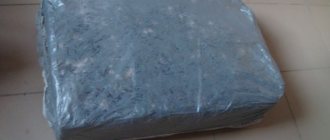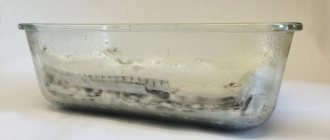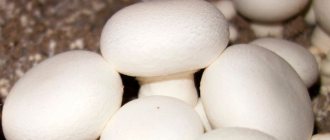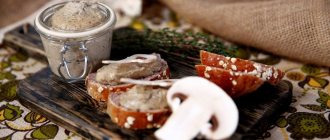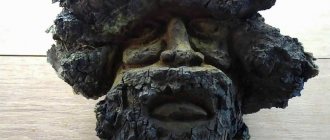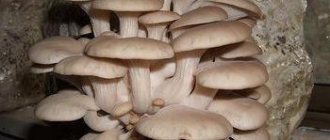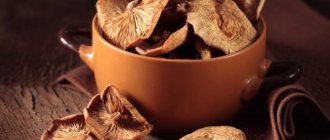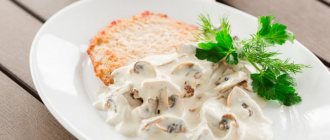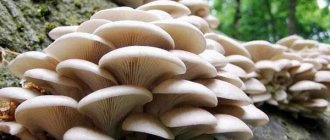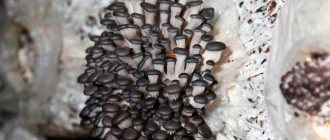Growing oyster mushrooms
For optimal development of mycelium, it is necessary to create certain conditions. Oyster mushrooms require a room temperature of 24 degrees, humidity - about 85%. Lights and ventilation are not turned on in the basement, as this slows down the growth of the mycelium.
If all the requirements for the substrate for oyster mushrooms and growing conditions are met, the mycelium grows in the third week. During this period, it is necessary to ensure that no mycelial crust forms on the surface. It germinates if there are too many fungal spores in the soil and the temperature is too high.
In growing any mushrooms, the substrate plays a special role. It must be balanced, properly formulated and nutritious, and also suitable for the growth and development of the selected type of mushroom.
How to grow oyster mushrooms at home, where to get mycelium
Any mushrooms grow from mycelium - that is, mycelium, which consists of thin white threads. Mycelium can develop from fungal spores that fall on a damp substrate or damp surface under conditions that are optimal for their growth. In the natural environment, such conditions occur in the forest, where mycelium was previously collected for cultivating mushrooms at home. Later they learned to breed mycelium (mycelium) in the laboratory and sell it for sale.
You should buy mycelium in specialized stores or from companies involved in breeding these mushrooms. The second option is preferable, because companies that grow mushrooms professionally are required to change the mycelium every year, and they sell the used one. Such mycelium is much cheaper than new one, although it is quite capable of reproducing mushrooms.
When purchasing mycelium, make sure that its color is white; small inclusions of the substrate are allowed. Good mycelium can only smell like wild mushrooms. To begin with, it is enough to buy a kilogram of mycelium; it should be stored in the refrigerator.
When buying ready-made mycelium, a gardener runs the risk of receiving a low-quality product, and this will ruin the entire enterprise. It makes sense to learn how to grow oyster mushroom mycelium yourself. This is done this way:
- A fresh, healthy mushroom is taken, cut in half and a piece of the cap is separated with tweezers.
- This fragment is treated with hydrogen peroxide for disinfection and a test tube with crushed millet grains or other substrate is placed.
- The closed tube is left for 14 days in a warm place without drafts or sunlight.
These operations require sterility! Dishes and instruments must be sterilized, contact of the substrate with the environment is excluded.
If too many spores got into the tube, or the temperature in the room was higher than normal, a mycelial crust may appear, then the operation should be repeated. Also, everything will have to be redone if a foreign odor appears and the surface is covered with moisture, which indicates contamination of the substrate with bacteria.
The finished mycelium looks like a white fluffy coating and has the smell of fresh mushrooms.
Substrate for tunnels
Preparation of a substrate for oyster mushrooms when grown using the tunnel method involves the use of soil containing cellulose, lignin, as well as fats and proteins. The main element is cereal straw. It is harvested in clear weather in environmentally friendly areas. Supplies of material for preparing the substrate for oyster mushrooms are prepared for a year in advance, but experienced mushroom growers recommend stocking up on straw for two years in advance. This is due to the fact that the amount of nitrogen in it increases and hygroscopicity increases.
The second component is sunflower husk, which must contain at least 15% moisture and at least 3% fat. The highest quality raw materials are harvested at the beginning of the harvesting season.
Sawdust without conifers is also introduced into the soil.
Mineral and nutritional supplements are used as additional substrate elements for oyster mushrooms. They help optimize the nitrogen content of finished raw materials. Typically, the mass of nutrient dry matter does not exceed 10% of the total mass of the soil.
To improve the structure of the nutrient mixture and maintain acidity at the required level, mineral additives are used in the form of alabaster, slaked lime, and soda ash.
How to grow oyster mushrooms in sawdust
Growing oyster mushrooms in bags with sawdust is a more complex method, but also more effective. The freshness of sawdust is of great importance, since pathogenic microorganisms can develop in old sawdust.
Sawdust from coniferous trees is not suitable for oyster mushroom substrate.
The sawdust must be dried to a moisture level of 7 - 10%, and it must be light, free-flowing and dry to the touch. There are few nutrients in sawdust; it is recommended to increase their content by adding beer wort. You can purchase it from a brewery or make it yourself.
Substrate preparation
Wheat or barley grains, washed in running water, are filled into some kind of dish such as a baking tray with a layer no thicker than two centimeters. This layer is covered with cold water and left for one and a half days. After this, the liquid is drained, and the swollen grain is covered with cotton cloth. The fabric is kept moist by periodically watering. After two days, the grain will germinate. When the sprouts reach a length of up to 8 mm, the grains are dried in the oven at 60°C. You can dry it simply by spreading the grains over the surface of the table at normal temperature.
The dried malt is ground to the consistency of ground coffee. Dilute with water at the rate of one part of powder to five parts of water. This mixture is steamed in a water bath for an hour and a half, stirring occasionally. After steaming, the mixture is filtered through cheesecloth. The resulting wort contains a lot of sugar and is rich in vitamins and amino acids.
Let's start the process
Before filling the bags with sawdust, they must be pasteurized. It is carried out as follows:
- The sawdust is placed in a bowl and poured with boiling water and wort at the rate of 200 g per 1 liter of water. There should be three times more liquid than sawdust.
- The dishes are carefully covered and left for 8 – 10 hours. Then the excess liquid is drained.
The cooled substrate and mycelium are compacted layer by layer into bags.
The substrate and mycelium must have the same temperature to prevent steaming of the mycelium.
After 45 days, the bag is opened and cross-shaped slits are made on the sides. After the germs of the mushrooms appear, watering begins and the lighting is turned on for 8 hours a day.
Mushrooms that are ripe for picking are twisted out, leaving stumps. The slits should be sealed with tape so that the moisture in the bags does not evaporate, and wait for the mycelium to appear. Then comes the second, and then the third wave of fruiting.
Growing oyster mushrooms at home may seem like a difficult task at first glance. But by carefully studying all the recommendations and carrying out this procedure for the first time, taking them into account, you will gain valuable experience. In the future, all actions will become familiar and will not cause difficulties. The resulting harvest will not only benefit and save the family budget, but will also provide an opportunity to be deservedly proud of your work.
Soil preparation
The substrate for growing oyster mushrooms in tunnels requires its preliminary preparation, which consists of carrying out the following work:
- Grinding. The smaller the substrate particles, the easier it will be for the mycelium to grow. This is especially important if fresh straw is used - it must be chopped.
- Mixing. If you plan to grow mushrooms on complex compost, which consists of several elements, then it is important to mix all the components until a homogeneous mass is obtained.
- Hydration. Mushrooms grow on a substrate with a fairly high level of humidity - the yield depends on this. The prepared compost is soaked in water until it absorbs the amount of moisture required to fully grow mushrooms.
Before using the substrate, excess water is squeezed out of it, achieving a humidity level of 70-80%. With this indicator, you can achieve maximum yield.
Basic nuances and requirements
Oyster mushrooms (also called oyster mushrooms) are a unique species that can grow in almost any soil , including dry grass, cotton fabric, thyrsus, or even coffee grounds! Being short-growing, oyster mushrooms can extract nutrients from everything that surrounds them. Another advantage of oyster mushrooms is the fairly fast pace of development - the first harvest can be harvested within 14 days after sowing.
To grow oyster mushrooms at home, you do not need any special skills or knowledge. A suitable place for this is a cellar or basement . Oyster mushrooms do not need a lot of light, and they are not thermophilic. If you don't have a basement, a barn or greenhouse . Despite its undemanding and unpretentious nature, the room in which mushrooms will be grown must be properly prepared.
Table. Conditions and equipment for growing.
| Name, photo | Short description |
| It all depends on which growing method is chosen. It is cheaper and more convenient to grow oyster mushrooms in bags - in this case they will require special supports with hangers. Give preference to plastic equipment - it will not rust and will be cheaper. You can also grow mushrooms on stumps, but more on that later. |
| The selected room must be clean. If there is fungus on the walls, the oyster mushrooms will begin to hurt (light spots will appear, density will be lost, they will become soft). To protect the crop, be sure to disinfect the basement. First, clean all surfaces, remove mold and dirt, then spray with a sulfate solution, and apply a solution of copper sulfate and lime to the ceiling and walls. |
| There is no need to create a greenhouse, but you cannot do without insulation and thermal insulation to retain moisture. The simplest heating devices must also be present so that the temperature is at least +13 degrees. A higher temperature (about +22-25 degrees) will only be required at first, immediately after planting the mycelium. The use of IR lamps is allowed. |
| For lighting, use garden fluorescent lamps, but in small quantities. Ventilate the room regularly - manually or using a special hood. Although such equipment is expensive, so purchasing it for small volumes of mushrooms is simply impractical. |
| These mushrooms love moisture very much, and therefore the air will need constant moisture. You can use electronic humidifiers or regular sprayers. It is important that the air humidity is between 70-90%. |
Expert opinion
Evgeny Shekhov
Mushroom picker with 12 years of experience, lives in the capital. For a long time now, he and his wife have not missed a single silent hunting season.
It is better not to use the room in which the fungus is found for cultivation. The situation will only get worse due to the high humidity that oyster mushrooms need. Crops will be affected by disease, become inedible or even poisonous.
Video - Arranging a basement for growing oyster mushrooms
Hydrothermal technique
To prepare a substrate for oyster mushrooms at home, hydrothermal processing technology is used. This is an important stage during which the spores of parasitic fungi are removed. For this purpose, high temperatures, microwave irradiation, and chemicals are used - the latter are used in large enterprises: hydrogen peroxide, sodium hypochlorite.
At home, in small areas, the soil can be treated in the microwave or simply pour boiling water over the substrate, allowing it to cool. After this, the excess liquid is drained and the transfer of the mycelium begins.
Peculiarities
There are many ways to prepare the substrate. For each type of mushroom, its own composition of components is selected. You can use coffee grounds, straw, stumps and even cardboard to prepare the soil composition.
The finished substrate for mushrooms must meet a number of requirements. Among them:
- Physical . They determine the properties of the substrate in relation to its moisture content, the size of the particle fractions of the feedstock, the degree of aeration and resistance to compaction or transformation into rot.
- Chemical . They establish requirements for the pH of the environment and the balanced content of nutrients in it.
- Biological . The sterility parameters of the finished substrate are determined.
- Environmental . The percentage of pesticides, radionuclides and heavy metals in the substrate is regulated.
Cooking rules
Prepare the substrate according to the following rules:
- The straw is crushed so that its particles are no larger than 8 cm.
- The prepared straw is laid out on a flat surface, where it will be moistened over several days, to a humidity level of 70–80%.
- The straw is then placed in the tunnels so that it forms a flat surface.
- The tunnel is closed and ventilation is turned on. Fresh air is gradually added to increase microbial activity in the mixture.
As soon as the substrate temperature reaches 60-65 degrees, pasteurization begins. High temperature treatment takes about 12-24 hours.
The main mistakes of novice mushroom growers
Below are some of the main mistakes that beginners often make when growing oyster mushrooms. Following the following growing guidelines and instructions will result in bountiful harvests and satisfying cultivation.
- Failure to comply with temperature conditions. The germination temperature of oyster mushroom mycelium, depending on the variety, must be brought closer to room temperature 19-23 ° C. The temperature of “shock” and growth of the mushroom is maintained several degrees lower than the germination temperature, amounting to 10-18 degrees C. For proper setting of fruiting bodies, oyster mushrooms must have a low temperature. The mushroom grows in natural conditions when the temperature drops below 15 degrees. If the temperature during the growth of oyster mushroom fruiting bodies is more than 20 degrees, the number of mushrooms that develop will decrease and the quality may decrease. This is the main problem with growing oyster mushrooms in summer.
Remember - oyster mushroom loves low temperatures - fruiting bodies grow even at 4 degrees C, the mycelium of the fungus is resistant to severe frosts. Frozen bales, when moved indoors, continue to produce mushrooms with better results - freezing stimulates fruiting in the next harvest.
- The certainty is that mushrooms love moisture. Mushrooms love moisture, but not water. This should be especially remembered. The substrate with mycelium should not stand in water. When watering mushrooms directly with water, remember that mushrooms can remain in water for 2 hours. After watering, oyster mushroom fruiting bodies should be dried quickly. Otherwise, the mushroom will become sticky on the surface, which leads to the development of bacterial diseases and deformation of the mushroom.
- Lack of fresh air. Many oyster mushroom lovers have the misconception that mushrooms do not like fresh air. For mushroom cultivation and proper development, the cultivated mycelium must have access to fresh air.
- The mycelium needs 200 lux of light - about 8-10 hours a day (light twilight) - light intensity that allows you to read newspapers. There is no need to expose the mycelium to direct sunlight. When grown outdoors, the mycelium should be placed in a shady place.
- Making additional holes, removing the film from the bag. A common mistake made by beginners is to poke extra holes in the film or remove the film completely. There is a prejudice - the more holes, the bigger the mushrooms. The rule works the other way around. Since the cultivation of mushrooms is carried out in amateur conditions, mushroom growers are not always able to provide adequately high humidity of 90-95 percent after making holes.
- Poor hygiene and pest control. The problem is the lack of “hygiene”, cleanliness of crops, especially during warm periods, for example, in late spring and summer, when the temperature exceeds 20 degrees. Mushrooms, especially old, perishable ones, attract flies feeding on the mycelium with their smell. Flies and larvae feed on the mycelium around the holes and cause many infections on the fruiting bodies of mushrooms. Therefore, it is important to remove old, dried or spoiled mushrooms as quickly as possible. Another hobbyist mistake is ignoring snails when cultivating outdoors. A snail can eat mushroom ovaries in one night and deprive the expected harvest. During the day, most snails are invisible; they are active in the evening and at night. Therefore, it is important to apply preventive measures, for example:
- tie the bag low to the ground on a tree;
- scatter sawdust and pine needles around, creating an impenetrable barrier for the snails.
Many people love mushrooms. The difference is what you like: eat, cultivate, collect, do business. Growing delicious oyster mushrooms at home will satisfy all your needs. Pleasure, benefit and profit at the same time, although a lot of work needs to be put in.
Soil treatment with steam
How to prepare a substrate for oyster mushrooms, what other technologies are used? The soil can be treated with steam. Moreover, this technology can be non-sterile and sterile. In the latter case, the substrate is exposed to high temperatures - up to 130 degrees - due to which all microflora in the soil dies. However, this method is expensive and is practically not used.
Steam treatment using a non-sterile method is carried out not only on large farms, but also at home. The substrate is poured with boiling water and allowed to cool for 3-4 hours. Then briquettes are formed for planting mycelium.
Caring for mushrooms after mycelium germination
When fruiting bodies appear, you need to change care:
- Move the bags to the second room and begin to gradually reduce the temperature to fifteen degrees.
- Ventilate regularly, in particular after watering, so that moisture does not linger on the hats.
- Keep humidity at 80-85%: a low level will lead to a poor harvest.
- Provide lighting of 100 to 150 lux. Two or three lamps with a power of 100 W per fifteen squares are quite suitable. Turn them on for 5-10 hours every day. With a lack of light, the mushroom legs take on an elongated appearance and are directed towards the lamps.
Growing technology
The entire growing technology can be divided into four stages. At the first stage, the substrate is prepared and processed. At home, soil disinfection is carried out with hot water. Some mushroom growers recommend boiling the substrate for two hours.
The substrate can be processed in this way in plastic bags, having previously made holes in them for free circulation of water. After draining the liquid, the soil is left to flow around for a day so that all excess moisture is removed. If disinfection was carried out in briquettes, then excess liquid is removed by placing the soil under a press.
The mycelium is planted under sterile conditions. The substrate is laid out in an even layer on the table and mixed with mushroom mycelium (2% mycelium per 10 kg of soil). Then the mixture is put into bags and compacted tightly. On one side, cuts are made on the bags at an angle of 45 degrees and about 5 cm long.
At a temperature of 25 degrees, mushroom germination occurs. During this period, it is necessary to ensure that the temperature does not rise above 30, otherwise the oyster mushroom will experience heat shock and the mushroom will die.
Harvesting occurs after 1.5-2 months. After the first harvest is harvested, the second will appear within two weeks. To speed up this process, the legs are cut off completely and the substrate is sorted.
How to make mushroom blocks without defects
1. Heat treatment of raw materials must be carried out using the hydrothermal method. Here* (link below) the technology is described in detail. It is important to follow all the recommendations from the article, as they are equally important. If you don’t have enough mycelium, or the bags run out, but the steamed husk is still left, you will have to throw it away. You can’t steam it again!
2. The time required for processing does not depend on the volume of the container.
3. The tank, barrel or bathtub in which the heat treatment is carried out must be completely covered (the lid of the tank as well) with foam plastic or foil-coated glass wool. If the container is not insulated, then near the walls the raw material will cool faster, some of it will not warm up, and the likelihood of defects will increase sharply.
So much substrate comes out of a two-hundred-liter barrel that it is enough for 5, maximum 6 mushroom blocks weighing 8.5-9 kg.
4. If you have just started working with oyster mushrooms, you can steam it by pouring hot water. In this case, it is necessary:
- the water must be at such a temperature that after pouring into the raw materials and mixing, the mass has a temperature of at least 80 degrees; - the container is insulated - this is necessary for high-quality heating of the entire husk and so that the temperature does not drop during heat treatment; - Keep sunflower husks at this temperature for at least 4 hours. I don’t recommend this method at all with straw. — after removing the steamed mass, the barrel (steaming tank) must be washed with clean water and treated with a bleach solution (100 g per 1 liter of water).
But this method is ONLY possible! if there is a special room for stuffing substrate mushroom blocks - a clean zone or also called a sowing room (driving room). It must be constantly treated to kill mold spores and bacteria.
And unfortunately, even a clean area does not guarantee that by simply pouring hot water over the raw materials you will be able to avoid green spots, spots of ungrowth, and bacterial contamination.
If this happens, you will have to switch to hydrothermal.
For more details on sowing, how to prepare mushroom blocks, knead the mycelium, stuff plastic bags, make cuts, read this article.
*Hydrothermy.
How to add lime
Consumption of straw and husk for oyster mushroom substrate
Vegetable dry mixtures increase by 2.5 - 3 times when soaked. This depends on the hygroscopicity of the mass and its initial moisture content.
Soaking husks or straw should be carried out not only so that the raw material gains moisture, but also for the spores to swell and begin to grow. Therefore, simply adding water and sowing immediately, without heating, is not an option at all. The spores will be active and will germinate along with the mycelium, the bag will be covered with greenery within 3-4 days.
Soak before heat treatment for at least 8 and no more than 12 hours, for more details see the article* (link at the bottom of the page).
How to calculate the amount of straw and husk for the substrate
From one kilogram of dry sunflower husk, straw, hay, you can get from two and a half to three kilograms of finished steamed mass.
In other words, to make 10 mushroom blocks weighing 10 kg each, you need from 25 to 30 kg of dry straw (or its mixture with hay) or husks. Plus three kilograms of mycelium (if you add 3%)
Article “Preparing oyster mushroom substrate at home”
